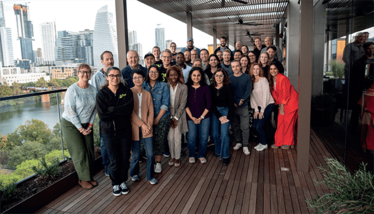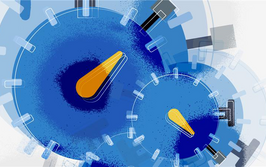Titan on the Horizon
Mammoth-resurrection company Colossal has spawned a digital pharma entity that wants to take cell and gene therapy to its next stage of evolution
Angus Stewart | | 6 min read | Interview

A new lifeform has sprung forth from Colossal – a company using genetic science to try and resurrect the mammoth, the Tasmanian tiger, and any number of other species that mankind has driven to extinction. But this new creature is corporate, not biological. It is called Form Bio, and we spoke to its Chief Strategy Officer, Claire Aldridge, about the work it is doing in the digital side of cell and gene therapy and beyond.
What drives you – and where has that drive taken you?
I’ve always loved science, but while working on my PhD in immunology and genetics, I realized that I did not want to be a bench scientist. I didn’t really like being in the lab and I found it lonely. Following graduation I was fortunate enough to get involved at University of Texas Southwestern Medical Center, where I found the place I wanted to apply my scientific knowledge: the translation step.
Thus, translation is where I have stayed for the last 25 years! I've been a biotech VC too, and that was very interesting; it forces you to consider how to identify good science that has an opportunity to change something in the marketplace. I’ve done translation work in a number of startups, too, which is especially fun because you not only shape where you’re going with the science, but shape the indications, the team, and the culture.
Before we get to Form Bio, can you explain the basics of Colossal?
Colossal is a startup spun out of George Church's lab at Harvard University; Ben Lamm is the founding CEO. One great way to move science forward is to pair a scientist with somebody who knows how to build businesses. When Ben launched Colossal he did it with a mission in mind: to restore lost biodiversity and resurrect the wooly mammoth. These animals didn’t die out because the ice age ended – plenty of their cold habitats still existed. They died out because our species hunted them to extinction. Colossal have targeted the mammoth in part because their image is so compelling – it engages the popular imagination and makes for a compelling first chapter in the company’s history.
Stepping away from the mere image, Colossal’s scientific project is to bring back “keystone species” that underpinned a range of natural environments and ecosystems. The wooly mammoth was key to the tundra, for example. Tasmanian Tigers are another illustrative example. European settlers in Australia drove them to extinction by 1936 – a tragedy from a biological standpoint because the species was a marsupial predator, which is a very rare kind of animal indeed. Colossal intends to use tools, such as genome analysis and CRISPR, to bring such species back.
Form Bio isn’t trying to bring back the mammoth; what’s the mission?
The leaders of Colossal knew early on that they couldn’t conjure the wooly mammoth from thin air. They needed – among other things – the right software. The right platform would make the entire project run faster, allow for smoother collaborations between the company and the academic labs it partnered with (in Harvard, the University of Melbourne, and the University of Connecticut), and bring in the latest and greatest bioinformatics algorithms.
In biology and molecular biology, we have some amazing tools, but we haven’t yet brought in the sophistication of advanced software. Targeted advertising software, for example, could provide a massive boost for individualized precision medicine. Colossal could find no software company in the marketplace able to meet their needs, so the company built its own software platform. While they were building it, they realized that the platform would have applications across the entire field of molecular biology – not just de-extinction. Any lab and any company doing anything with vast quantities of data and next generation tools like CRISPR needs validated ways to analyze its data. Across the field, we all generate more data than we can handle. Therefore, until we have the right tools we won’t be able to bask in the full benefits that all of that data can offer.
At Form, we have pulled that software platform out and are working on further developing and selling it – while still supporting our parent company. Colossal is our biggest customer now, but they won’t be forever.
Cell and gene therapy is going places, but facing serious challenges too. How can digital tools offer material change?
In cell and gene therapy, the product comes straight from the academic lab. Once it has gone through animal testing, it gets licensed to the company who will move it forward. Consideration from the manufacturing perspective comes into the process rather late. Contrast this with small molecule medicine, in which you begin with a small molecule that you fully understand and need to figure out how to make lots of it. For the sake of producing more drugs, cheaper drugs, and safer drugs, we need to bring the same capability into the cell and gene field. There are ways that process improvements, such as boosting purification and cell lines, can help – but they won’t be enough to give us the level-up that we need. What the field needs is a construct that will replicate efficiently.
Machine learning will be crucial to this endeavor. With one of our own machine learning tools, we were analyzing truncations – errors that occur when machinery replicating DNA “gets stuck” because of a secondary or tertiary structure. In our in silico modeling, we found that it only takes a few changes to the nucleotides to reduce truncations by 70 percent. We’re currently in the process of validating these findings in the wet lab. There is a huge potential here for safer, more efficient production – all made possible by digital tools.
What is the greatest possible outcome of the cell and gene therapy field? Anything as bombastic as a real live mammoth?
Its potential is to revolutionize the way we treat disease. Paying $3.5 million to correct a single hemophilia mutation may seem a very large upfront cost, but it is still a far lower than a lifetime of payments for conventional treatment. If we can bring that cost down so that it is more scalable, we could fundamentally make medicine more precise and more personalized. One day, a cancer diagnosis could be immediately followed by a cell therapy specific for your type of cancer.
In gene therapy, there is the potential to turn disease management into disease modification, or chronic care into a cure. For example, recent work demonstrated that edits in the liver can reduce cholesterol formation. Cardiovascular disease is one of the largest killers right now, so herein lies the potential to change the health longevity of entire populations.
I am passionate about making all therapies like these more “off-the-shelf” and accessible. Making these therapies easier to manufacture and easier to place on a freezer shelf is one way that we can make them more available to the poor, the marginal, and the underserved.
In 2022, Colossal received funding from CIA’s venture capital firm. Are you expecting such high-level support at Form?
We’re keeping all our options open. We just raised a round that will give us well over two years of runway, but we still love having conversations with potential investors and getting them excited about the work that we’re doing. I think the breadth of the investors that we might be able to engage with is incredibly large, so we shall see where that takes us.
Between studying for my English undergrad and Publishing master's degrees I was out in Shanghai, teaching, learning, and getting extremely lost. Now I'm expanding my mind down a rather different rabbit hole: the pharmaceutical industry. Outside of this job I read mountains of fiction and philosophy, and I must say, it's very hard to tell who's sharper: the literati, or the medicine makers.



















